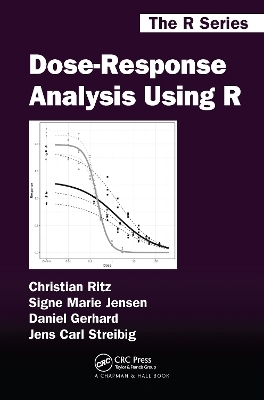
Dose-Response Analysis Using R
Seiten
2021
Chapman & Hall/CRC (Verlag)
978-1-032-09181-5 (ISBN)
Chapman & Hall/CRC (Verlag)
978-1-032-09181-5 (ISBN)
Dose-response analysis is a technique used to determine the safe and hazardous dosage of drugs, pollutants, and other substances to which humans and other organisms are exposed. This book provides a practical and comprehensive overview of methods for dose-response analysis.
Nowadays the term dose-response is used in many different contexts and many different scientific disciplines including agriculture, biochemistry, chemistry, environmental sciences, genetics, pharmacology, plant sciences, toxicology, and zoology.
In the 1940 and 1950s, dose-response analysis was intimately linked to evaluation of toxicity in terms of binary responses, such as immobility and mortality, with a limited number of doses of a toxic compound being compared to a control group (dose 0). Later, dose-response analysis has been extended to other types of data and to more complex experimental designs. Moreover, estimation of model parameters has undergone a dramatic change, from struggling with cumbersome manual operations and transformations with pen and paper to rapid calculations on any laptop. Advances in statistical software have fueled this development.
Key Features:
Provides a practical and comprehensive overview of dose-response analysis.
Includes numerous real data examples to illustrate the methodology.
R code is integrated into the text to give guidance on applying the methods.
Written with minimal mathematics to be suitable for practitioners.
Includes code and datasets on the book’s GitHub: https://github.com/DoseResponse.
This book focuses on estimation and interpretation of entirely parametric nonlinear dose-response models using the powerful statistical environment R. Specifically, this book introduces dose-response analysis of continuous, binomial, count, multinomial, and event-time dose-response data. The statistical models used are partly special cases, partly extensions of nonlinear regression models, generalized linear and nonlinear regression models, and nonlinear mixed-effects models (for hierarchical dose-response data). Both simple and complex dose-response experiments will be analyzed.
Nowadays the term dose-response is used in many different contexts and many different scientific disciplines including agriculture, biochemistry, chemistry, environmental sciences, genetics, pharmacology, plant sciences, toxicology, and zoology.
In the 1940 and 1950s, dose-response analysis was intimately linked to evaluation of toxicity in terms of binary responses, such as immobility and mortality, with a limited number of doses of a toxic compound being compared to a control group (dose 0). Later, dose-response analysis has been extended to other types of data and to more complex experimental designs. Moreover, estimation of model parameters has undergone a dramatic change, from struggling with cumbersome manual operations and transformations with pen and paper to rapid calculations on any laptop. Advances in statistical software have fueled this development.
Key Features:
Provides a practical and comprehensive overview of dose-response analysis.
Includes numerous real data examples to illustrate the methodology.
R code is integrated into the text to give guidance on applying the methods.
Written with minimal mathematics to be suitable for practitioners.
Includes code and datasets on the book’s GitHub: https://github.com/DoseResponse.
This book focuses on estimation and interpretation of entirely parametric nonlinear dose-response models using the powerful statistical environment R. Specifically, this book introduces dose-response analysis of continuous, binomial, count, multinomial, and event-time dose-response data. The statistical models used are partly special cases, partly extensions of nonlinear regression models, generalized linear and nonlinear regression models, and nonlinear mixed-effects models (for hierarchical dose-response data). Both simple and complex dose-response experiments will be analyzed.
Christian Ritz is an Associate Professor at the University of Copenhagen, Denmark. Signe M. Jensen is an Assistant Professor at the University of Copenhagen, Denmark. Daniel Gerhard is a Senior Lecturer at the University of Caterbury, New Zealand. Jens Carl Streibig is Professor Emeritus at the University of Copenhagen, Denmark.
Introduction
Dose-response models
Estimation procedures
Model selection and model averaging
Model diagnostics and how to fix violations
Inverse regression
Simultaneous inference
Grouped data
Nonlinear mixed effects models
Design of experiments
Appendix
| Erscheinungsdatum | 01.07.2021 |
|---|---|
| Reihe/Serie | Chapman & Hall/CRC The R Series |
| Zusatzinfo | 47 Illustrations, black and white |
| Sprache | englisch |
| Maße | 156 x 234 mm |
| Gewicht | 340 g |
| Themenwelt | Mathematik / Informatik ► Mathematik |
| Studium ► 2. Studienabschnitt (Klinik) ► Pharmakologie / Toxikologie | |
| Naturwissenschaften ► Biologie ► Biochemie | |
| ISBN-10 | 1-032-09181-9 / 1032091819 |
| ISBN-13 | 978-1-032-09181-5 / 9781032091815 |
| Zustand | Neuware |
| Informationen gemäß Produktsicherheitsverordnung (GPSR) | |
| Haben Sie eine Frage zum Produkt? |
Mehr entdecken
aus dem Bereich
aus dem Bereich
Buch | Hardcover (2024)
Thomas Karow (Verlag)
57,80 €
Buch | Hardcover (2022)
Urban & Fischer in Elsevier (Verlag)
99,00 €


